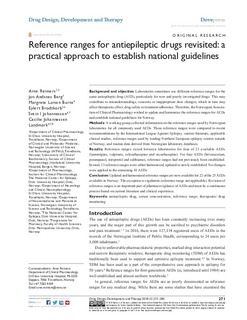| dc.contributor.author | Reimers, Arne | |
| dc.contributor.author | Berg, Jon Andsnes | |
| dc.contributor.author | Burns, Margrete Larsen | |
| dc.contributor.author | Brodtkorb, Eylert | |
| dc.contributor.author | Johannessen, Svein Ivar | |
| dc.contributor.author | Landmark, Cecilie Johannessen | |
| dc.date.accessioned | 2018-02-19T12:54:54Z | |
| dc.date.available | 2018-02-19T12:54:54Z | |
| dc.date.created | 2018-02-08T11:47:44Z | |
| dc.date.issued | 2018 | |
| dc.identifier.citation | Drug Design, Development and Therapy. 2018, 12, 271-280. | nb_NO |
| dc.identifier.issn | 1177-8881 | |
| dc.identifier.uri | http://hdl.handle.net/11250/2485687 | |
| dc.description.abstract | Background and objective: Laboratories sometimes use different reference ranges for the same antiepileptic drug (AED), particularly for new and poorly investigated drugs. This may contribute to misunderstandings, concerns or inappropriate dose changes, which in turn may affect therapeutic effect, drug safety or treatment adherence. Therefore, the Norwegian Association of Clinical Pharmacology wished to update and harmonize the reference ranges for AEDs and establish national guidelines for Norway.
Methods: A working group collected information on the reference ranges used by Norwegian laboratories for all commonly used AEDs. These reference ranges were compared to recent recommendations by the International League Against Epilepsy, current literature, applicable clinical studies, reference ranges used by leading Northern European epilepsy centers outside of Norway, and routine data derived from Norwegian laboratory databases.
Results: Reference ranges varied between laboratories for four of 23 available AEDs (lamotrigine, valproate, eslicarbazepine and oxcarbazepine). For four AEDs (brivaracetam, perampanel, stiripentol and sulthiame), reference ranges had not previously been established. In total, 13 reference ranges were either harmonized, updated or newly established. No changes were applied to the remaining 10 AEDs.
Conclusion: Updated and harmonized reference ranges are now available for 22 of the 23 AEDs available in Norway. The exception is vigabatrin (reference range not applicable). Revision of reference ranges is an important part of pharmacovigilance of AEDs and must be a continuous process based on current literature and clinical experience. | nb_NO |
| dc.language.iso | eng | nb_NO |
| dc.publisher | Dove Medical Press | nb_NO |
| dc.rights | Navngivelse-Ikkekommersiell 4.0 Internasjonal | * |
| dc.rights.uri | http://creativecommons.org/licenses/by-nc/4.0/deed.no | * |
| dc.title | Reference ranges for antiepileptic drugs revisited: a practical approach to establish national guidelines | nb_NO |
| dc.type | Journal article | nb_NO |
| dc.type | Peer reviewed | nb_NO |
| dc.description.version | publishedVersion | nb_NO |
| dc.source.pagenumber | 271-280 | nb_NO |
| dc.source.volume | 12 | nb_NO |
| dc.source.journal | Drug Design, Development and Therapy | nb_NO |
| dc.identifier.doi | 10.2147/DDDT.S154388 | |
| dc.identifier.cristin | 1563154 | |
| dc.description.localcode | © 2018 Reimers et al. This work is published and licensed by Dove Medical Press Limited. The full terms of this license are available at https://www.dovepress.com/terms.php and incorporate the Creative Commons Attribution – Non Commercial (unported, v3.0) License (http://creativecommons.org/licenses/by-nc/3.0/). By accessing the work you hereby accept the Terms. Non-commercial uses of the work are permitted without any further permission from Dove Medical Press Limited, provided the work is properly attributed. For permission for commercial use of this work, please see paragraphs 4.2 and 5 of our Terms (https://www.dovepress.com/terms.php). | nb_NO |
| cristin.unitcode | 194,65,15,0 | |
| cristin.unitcode | 194,65,30,0 | |
| cristin.unitname | Institutt for klinisk og molekylær medisin | |
| cristin.unitname | Institutt for nevromedisin og bevegelsesvitenskap | |
| cristin.ispublished | true | |
| cristin.fulltext | original | |
| cristin.qualitycode | 1 | |

